SDSU has all the pieces but where do they fit this season?
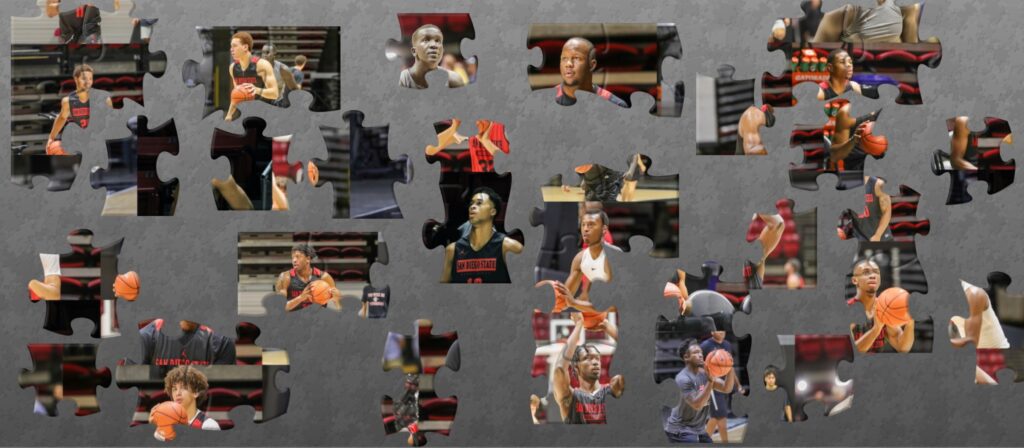
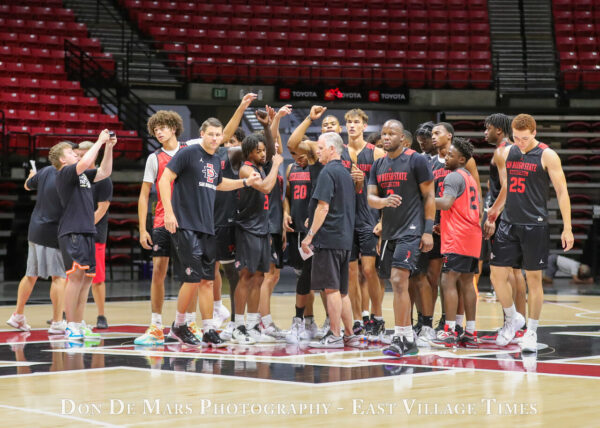
Game planning in college basketball is far more intense than in the NBA regular season. Professionals play four or five times a week, which makes implementing opponent-specific strategies before the playoffs challenging.
College basketball, save for tournaments like the Maui Invitational SDSU will be playing in November, is different. Coaches have multiple days between most games to install whatever strategies they think will give their team the best chance of winning. As teams scout SDSU, the Aztecs’ ability to play multiple lineups with varying styles at a high level is a tremendous advantage.
Never before in the Fisher/Dutcher era has a squad, on paper, had the versatility the 2022-2023 squad possesses. The Sweet Sixteen teams led by Kawhi Leonard and Xavier Thames had one style. They were long, athletic, positionless teams that dominated their opponents on the glass. Like most teams, they had a single identity on the court. Game planning against them was relatively easy. Defeating them was a different story. Of all the teams to grace the Mesa over the past few decades, the 2019-2020 Aztecs that went 30-2 were the closest to this year’s squad in terms of versatility.
At the beginning of that season, Dutcher had the luxury of playing three ways. Jordan Schakel started at small forward with Yanni Wetzell and Nathan Mensah inside. The three-guard lineup created space for Malachi Flynn. When Matt Mitchell substituted in for Schakel, it gave the Aztecs a bigger frontline, and SDSU resembled the Sweet Sixteen teams mentioned above. At times, Dutcher elected to play small. He slid Mitchell to the four, with Schakel at the three and Aguek Arop at the five. By playing multiple styles in one game, Dutcher’s team usually had a decided mismatch each night. Opposing coaches game planned against all three, but with practice time a scarce commodity, every moment they spent figuring out one style was time not given to another.
The versatility of that team also helped to ease the loss when Mensah was forced to stop playing. Already accustomed to playing small, the team transitioned seamlessly. Dutcher moved Wetzell to the five and inserted Mitchell into the starting lineup at the four.
The Malachi Flynn-led Aztecs could compete at a championship level using three playing styles. This year’s squad has the potential to play even more. The task Dutcher and his staff have is deciding if they can win using so many lineups. Their versatility could be the rare occasion where there is too much of a good thing. SDSU risks being the “jack of all trades but the master of none.”
Below are six intriguing lineups for SDSU this season. The list is far from exhaustive, and various players could be plugged into the multiple styles. If Dutcher can utilize many of them during a game, SDSU will be impossible to properly prepare for. Tuesday’s exhibition against San Diego Christian is the first opportunity to see which mix of players have caught the coaches’ eyes as they look to mold their rotation.
[wpedon id=”49075″ align=”right”]
Transition Offense
PG Darrion Trammell, SG Lamont Butler, SF Matt Bradley, PF Jaedon LeDee, C Nathan Mensah
Among the favorites to be the lineup SDSU tip offs with against Cal State Fullerton on November 7th, it gives Dutcher a little bit of everything. There are shooters to space the floor, dominant rebounders to punish teams on the boards, and any lineup with Mensah and Lamont Butler will be a defensive menace. What this unit brings more than any other rotation is the possibility for transition offense.
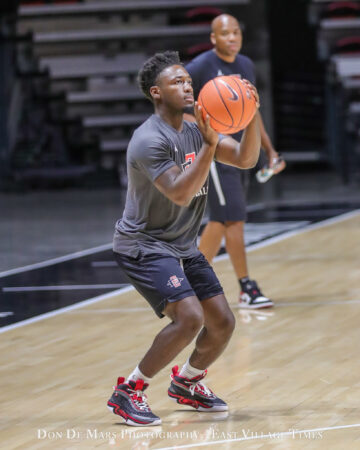
Last season’s team listed a pair of point guards in the starting lineup in, Butler and Trey Pulliam; the reality was that Pulliam was the primary ball handler. His methodical pace was not conducive to pushing the ball. Butler and Trammell, on the other hand, should seamlessly be able to receive the inbounds pass and go. When they get in the half-court, either guard should have the ability to play in the pick-and-roll. Dutcher’s stated goal is to score more in transition. This is the lineup best suited to accomplish that.
The weakness of this unit is more of a question at this point. Can Trammell and Butler play together in the half-court? Early returns are not promising. Butler’s +/- against UCLA was -16. There are no good statistics in sports that will predict what is going to happen in the next game, and as far as stats go, +/- is among the worst. Nonetheless, it is noteworthy. This lineup forces Trammell and Butler to play off the ball. With plenty of other options at shooting guard, the duo needs to be elite when the ball is not in their hands.
Small Ball
PG Darrion Trammell, SG Matt Bradley, SF Miles Byrd, PF Micah Parrish, C Jaedon LeDee
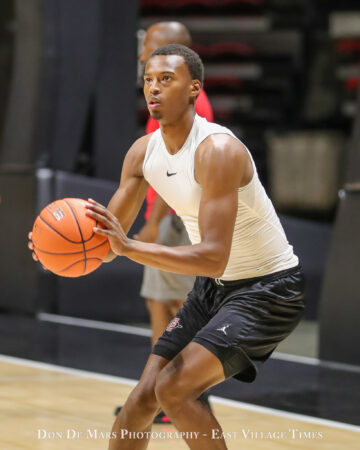
Micah Parrish gives Dutcher the opportunity to enlist the style he used when Mitchell was on the Mesa. Parrish is a willing rebounder who averaged nearly six boards a season ago. If he and the guards rebounding behind him are able to control the defensive glass, this unit would be a matchup nightmare on the offensive end. Every player in this unit can shoot or drive to the basket. This lineup would also match up well defensively against teams in the Mountain West that typically employs smaller units.
This group has the same weaknesses Syracuse exposed two years ago in the NCAA tournament. If the team has a poor shooting night, it does not have a lot of other ways to score. Trammell’s effectiveness in the pick and roll could make an off night less likely, but poor shooting is part of basketball, no matter the level.
Bully Ball
PG Lamont Butler, SG Matt Bradley, SF Keshad Johnson, PF Jaedon LeDee, C Nathan Mensah
North Carolina entered the 2021 NCAA Tournament as an eight seed with all the talent in the world, but a key weakness, they did not shoot the ball well inside of the three-point line. Their 44.7 FG% was 133rd in the nation. In the Tourney, they fared even worse. They only converted 41.5% of their 395 attempts. 33 teams shot better than the Tar Heels during the NCAA Tournament. It almost did not matter.
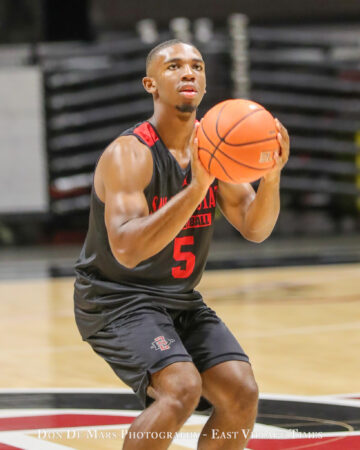
UNC made it to the championship game primarily on the strength of their rebounding. They led the field with a 13.0 rebounding margin while collecting 94 offensive boards. In the final game, a 72-69 loss to Kansas, they shot 31.5%. They were not blown out because they grabbed 23 boards on the offensive end.
SDSU has the potential to be this dominant of a rebounding team if Dutcher and his staff decide to play their biggest athletes together. UCLA’s final game a year ago was against North Carolina, and their first this season was an exhibition against the Aztecs. The Tar Heels had nine more rebounds than the Bruins, the Aztecs were plus 10. UNC shot 40.9% from the field and had 15 offensive boards while surrendering eight. SDSU shot 41.8%, brought down 20 on the offensive glass, and gave up 10. Comparing a Sweet Sixteen matchup to a scrimmage is dubious at best, but the numbers do provide some context.
The other part of North Carolina’s recipe was good three-point shooting. They were 62nd in the country from deep with a 35.5 3P%. The weakness of this lineup is it would make SDSU a half-court team and put one of its best players on the bench. Opponents would test it to see if they could excel from the outside enough to make its rebounding strength matter.
Defense
PG Lamont Butler, SG Adam Seiko, SF Matt Bradley, PF Keshad Johnson, C Nathan Mensah
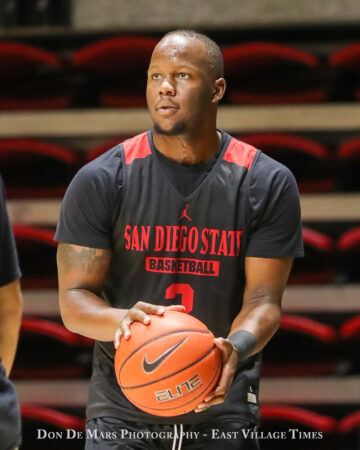
This unit is basically a better version of last season’s 23-9 team that should have advanced to the round of 32 in the NCAA Tournament. Another year older, this group has played many important games together and would excel especially on the defensive end. Last year, Bradley was new to the defense, and it showed at times. Bradley should make significant improvements on that side of the ball in 2022-2023.
As it was a year ago, scoring would be the primary weakness of this group. The space Bradley is expected to have on the offensive side of the ball could evaporate, although Butler and Johnson’s offseason improvement could reverse last year’s trend. Transition scoring would also be a challenge.
Shooters
PG Darrion Trammell, SG Adam Seiko, SF Matt Bradley, PF Micah Parrish, C Jaedon LeDee
This is a variation of the “small ball” unit above and has even less size. It substitutes 6’7 Miles Byrd with 6’3 Adam Seiko to put all the Aztecs’ best shooters on the court together. This is an offensive lineup with Seiko, Bradley, and Parrish spacing the floor for Trammell and LeDee to work in the pick-and-roll. With good ball movement, this unit should generate frequent open looks and some highlight dunks from Trammell to LeDee.
This lineup’s weakness is controlling the boards and playing against bigger lineups. While it lacks on the defensive side of the ball, it could be an effective grouping for a few minutes each game if Dutcher inserted it at the proper time. If this group can play even in those areas, it has high-scoring potential.
Positionless
PG Lamont Butler, SG Adam Seiko, SF Micah Parrish, PF Elijah Saunders, C Aguek Arop
Fisher and Dutcher were part of the avant-garde in playing positionless basketball. The revolution they led with Michigan’s Fab Five and Kawhi Leonard’s NBA success has opened the door for “tweeners” at all levels. Tapping into these roots, Dutcher could employ a lineup with the Aztecs that defies convention altogether.
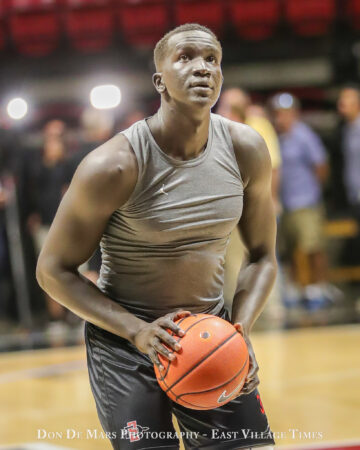
Offensively, this lineup works if Butler’s rumored summer growth materializes. With Parrish, Seiko, and Saunders stretching the floor and Arop looking for opportunities to cut to the basket, Butler should have a lot of space to operate. Like the Xavier Thames-led Aztecs, this group would score in a variety of unscripted ways. Defensively, the unit would be terrific at pressing its opponents, it could switch all ball screens and allow Dutcher to get creative with giving alternative looks.
Low post defense against true centers would be a matchup problem. Finding offense outside of Butler, offensive rebounds, and hustle plays could be an issue.
My earliest sport’s memory involve tailgating at the Murph, running down the circular exit ramps, and seeing the Padres, Chargers and Aztecs play. As a second generation Aztec, I am passionate about all things SDSU. Other interests include raising my four children, being a great husband and teaching high school.